|
Getting your Trinity Audio player ready...
|
Established 2000
Cuyahoga Valley National Park, bursting with history and culture, offers year-round adventures in untouched wilderness just outside the city. Check out our guide for tips on exploring its seasonal beauty.
Overview
Nestled between Akron and Cleveland in Northeast Ohio, Cuyahoga Valley National Park is a hidden treasure that preserves the rural landscape along the Cuyahoga River. Its unique location makes it easily accessible from both cities, yet it remains a tranquil escape from urban life. The heart of the park lies in the Cuyahoga River valley, surrounded by charming homes, picturesque roads, and enchanting forests that stretch across rolling hills.
Covering an impressive 32,783 acres of land (equivalent to 51.2 square miles or 132.7 square kilometers), this park is under the administration of the National Park Service. However, there are also sections within its boundaries that are managed by local county parks or other public and private businesses.
Cuyahoga Valley National Park is also a popular spot for recreation and education in the nearby city area. With more than 125 miles of hiking paths, the park provides ample opportunities for visitors to discover and gain knowledge about its diverse ecology. Initiatives such as the Junior Ranger program, alongside collaborations with local groups and universities like Kent State University’s Wick Poetry Center, strive to cultivate a deeper understanding and admiration for the park’s natural treasures.
Once you enter the park, it’s hard not to be captivated by the stunning natural features that have been cherished by residents for many years. In order to preserve its value and prevent development from taking over, locals fought tirelessly to have this area designated as a protected park. Originally established as a National Recreation Area in 1974, it was later given the status of a national park in 2000 – making it the only one of its kind with this origin story. Surprisingly, some houses that were already built within the designated area still stand today – an uncommon sight in a national park.
Table of Contents:
Article Navigation: Click on any of the listed items in the table of contents below to jump to that section of the article. Similarly, clicking on any large, white section header will jump you back to the Table of Contents.
Human History
No Native American tribes in Ohio have federal recognition, but the former inhabitants of the Cuyahoga Valley were Native Americans. The Lenapé Nation, known as the Lenape’wàk or Delaware Nation, were influential in the upper Ohio River Valley and had a democratic and egalitarian social structure. They excelled in trade and craftsmanship. Due to wars and treaties, they migrated west and south from their origins in present-day New York through Ohio to their current homes in Oklahoma and Ontario.
Land was vital to the Lenapé Nation for hunting and agriculture. As they were pushed west, their relationship with the land was disrupted. They formed alliances with other Lenapé communities in order to preserve culture and resources. The introduction of the fur trade caused a shift in hunting practices, leading to a decline in beaver populations. Trade networks relied on waterways used by indigenous people for centuries.
Portage Path, an eight-mile trail in modern-day Summit County, Ohio, connected the Cuyahoga and Tuscarawas Rivers. It was used by American Indians to transport canoes from one river to the other, creating a water route from the Great Lakes to the Gulf of Mexico. Today, most of the path is located in Akron, Ohio, and signs mark its route between the two rivers. The name “Portage County” originated from this path.
The Lenapé Nation lost their land in the Cuyahoga Valley due to coercive tactics and conflicts with European settlers. The 1795 Treaty of Greenville established the Cuyahoga River as a boundary between indigenous lands and settlement. Later treaties also took Lenapé land without full consent. Today, the Lenapé are known as the Delaware Nation and have headquarters in Oklahoma, with populations in other states and Canada.
The valley became a recreational spot in the 1870s, with carriage rides and boat trips along the canal. Development began in the 1910s and 1920s, and in 1929, a donation of 430 acres was made for park purposes. The Civilian Conservation Corps built much of the park’s infrastructure in the 1930s, including the Happy Days Lodge.
In the 1960s, local residents were concerned about the potential for urban sprawl to destroy the natural beauty of the Cuyahoga Valley, despite efforts to protect certain areas with regional parks. Another worry was the pollution and damage to the Cuyahoga River due to factory waste and sewage, as well as frequent fires on the river in 1952 and 1969. To address these issues, citizens collaborated with state and national government officials to find a lasting solution. Finally, on December 27, 1974, President Gerald Ford signed a bill creating the Cuyahoga Valley National Recreation Area. While the administration initially recommended vetoing the bill because they believed the park did not possess any noteworthy qualities and they were already funding outdoor recreation opportunities, it ultimately passed into law.

Blue Hen Falls, Cuyahoga Valley National Park, Ohio.
Ecology
Cuyahoga Valley National Park’s ecology is a beautiful display of the various and lively ecosystems found within its boundaries. The park boasts an array of plants and animals, as well as distinctive geological structures and wetlands.
The park is home to a diverse array of life, with over 900 different plant species, 200 types of birds, 91 aquatic macroinvertebrates, 43 fish varieties, and 32 mammal species. Additionally, there are 22 amphibian species and 20 types of reptiles found within the park’s boundaries. This impressive range of biodiversity is made possible by the park’s various habitats, which include mixed-mesophytic forests, wetlands, and agricultural areas.
With more than 1,500 wetlands, the park serves a vital purpose in providing ecological services and serving as a habitat for almost half of all endangered species. Sadly, these wetlands are threatened by non-native invasive plants and pollution. To combat this, the National Park Service has implemented extensive monitoring procedures to assess the health of select wetlands and aid in restoration efforts.
The Cuyahoga River also winds through the park, with its own turbulent history. Once heavily contaminated, the river has undergone extensive restoration efforts, showcasing nature’s resilience and the significance of conservation.
Cuyahoga Valley National Park’s ecology is a rich mosaic of various ecosystems and a tribute to the importance of preserving nature. It not only benefits the surrounding community but also serves as an example of the tenacity and splendor of the natural world for people far beyond its borders.
Geology
With a history spanning 400 million years, the geological features of Cuyahoga Valley National Park tell a captivating story of past seas, glaciers, and rivers that have shaped the landscape. Located between Cleveland and Akron in Ohio, this park not only boasts diverse flora and fauna but also showcases a varied geological heritage.
The bedrock of the park is made up of various sedimentary rock layers, such as the Ohio Shale, Bedford Shale, Berea Sandstone, Cuyahoga Formation, and Sharon Conglomerate. These layers were created over time as the area underwent changes from oceanic, river, and glacial forces.
The park’s landscape is varied and includes river terraces, steep valleys, winding streams, gorges, waterfalls, and rocky cliffs. These features all offer insights into the geological past of the region. One notable spot within the park is the Ledges, a popular destination for visitors. Here, the conglomerate rocks serve as proof of ancient river systems that once existed in this area.
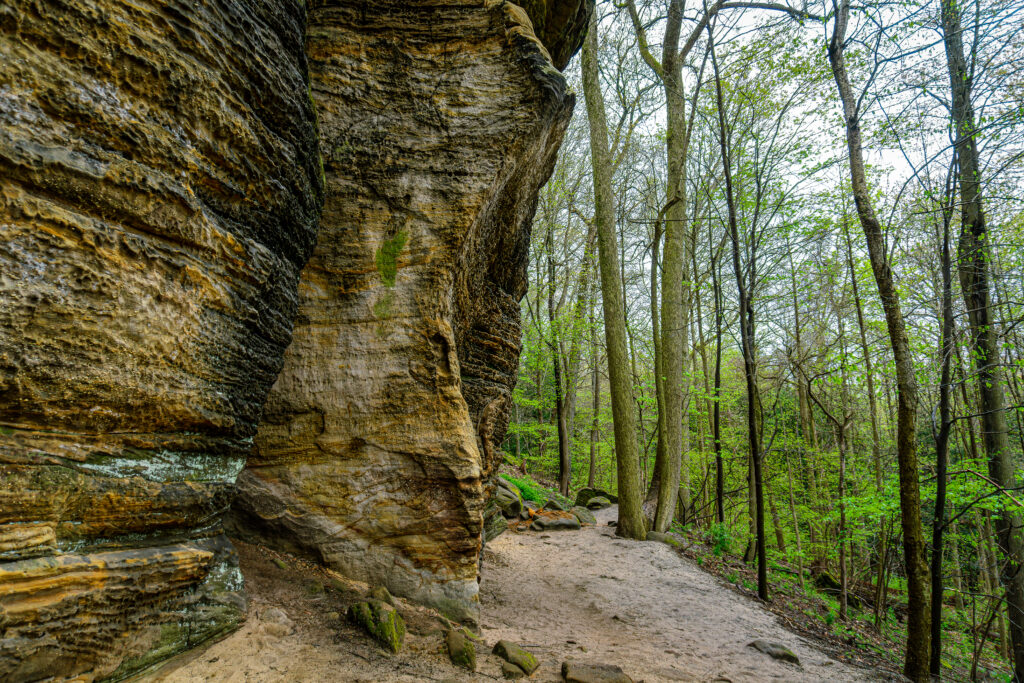
The Ledges Trail winds through cliffs and boulders of Sharon Conglomerate.
The history of the park is closely tied to the overall geological history of the Appalachian Plateaus Physiographic Province. The formation of the bedrock in this area occurred during the Paleozoic Era, approximately 410 to 315 million years ago. This time period was characterized by repeated deposition and erosion of various substances such as clay, silt, sand, and gravel in a shallow sea.
Skipping ahead to the Ice Age, we see that glaciers had a major impact on northeastern Ohio, moving through the area at least four times. As they made their way down from the north, these massive sheets of ice covered the land and filled in old river valleys with glacial deposits. The Cuyahoga Valley, too, was shaped by millions of years of natural forces such as rivers, glaciers, and oceans.
The park boasts a diverse range of geological formations that have been shaped by its complex history. Among them are Brandywine Falls and Blue Hen Falls, both created by the force of water carving into the solid rock. Another attraction for hikers is the Ritchie Ledges, where massive chunks of orange and yellow conglomerate jut out, resembling a giant’s personal collection of rocks.
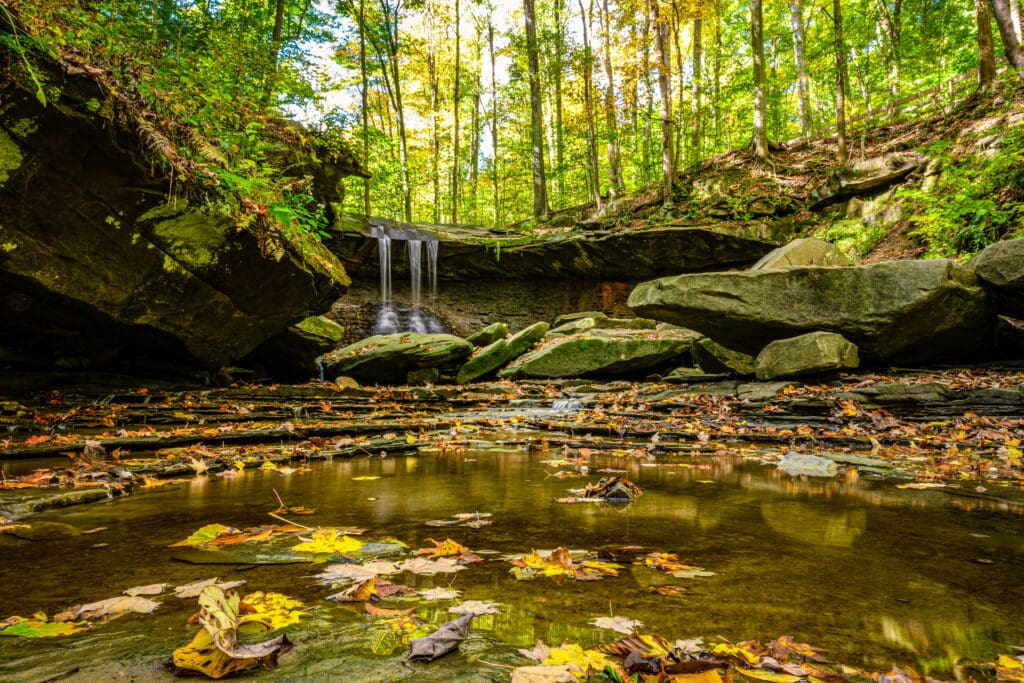
Leaves float in the pool below Blue Hen Falls in Cuyahoga Valley National Park.
The geological features of the park have a significant impact on its ecological system. The various habitats, including wetlands and forests, are sustained by the diverse geological formations. Of all the endangered species in the park, almost half rely on the wetlands for critical ecological services and as their natural habitat.
To summarize, the geology of Cuyahoga Valley National Park stands as a testament to the strength of nature and the enduring qualities of the terrain. The sedimented rock layers formed by ancient oceans and the carved valleys left behind by glaciers tell a story of continuous transformation and resilience. This serves as a poignant reminder of our planet’s extensive past and the ongoing processes that shape it.
Where to Stay
When visiting Cuyahoga Valley National Park, you have a variety of accommodations to choose from, each offering a unique experience. Here are the best places to stay, based on your preferences and interests.
Hotels
-
The Inn at Brandywine Falls: A historic bed and breakfast overlooking the stunning 65-foot Brandywine Falls, offering elegant, candlelight breakfasts and easy access to nearby trails.
-
Stanford House: A high-quality day or overnight use facility, providing moderately priced accommodations, featuring a self-service kitchen, comfortable living room, and scenic park-grounds.
-
Sheraton Suites Akron Cuyahoga Falls: Overlooking the gorge of the Cuyahoga river, this hotel offers an indoor pool, restaurant, and is close to the Akron Zoological Park.
-
Fairfield Inn & Suites by Marriott Akron Fairlawn: A well-reviewed hotel, providing a comfortable stay with amenities including a 24-hour snack shop and an indoor pool.
-
Courtyard Cleveland Independence: Just off Interstates 480 and 77, this hotel features spacious rooms with LCD TVs and in-room coffee facilities, as well as an indoor pool and fitness center.
-
Hampton Inn & Suites Cleveland-Independence: Located near the Cleveland Metroparks Zoo, this hotel offers a comfortable stay with amenities including a 24-hour snack shop and an indoor pool.
-
Hilton Akron/Fairlawn: Directly across from the Summit Mall, this hotel provides on-site dining options, spacious guestrooms, and is close to local attractions.
-
Holiday Inn Cleveland – South Independence, an IHG Hotel: A comfortable hotel offering free bikes and a fitness center, located in Independence, Ohio.
-
Candlewood Suites – Cleveland South – Independence, an IHG Hotel: Featuring barbecue facilities, this hotel is located in Independence, Ohio, offering a comfortable stay with amenities including a fitness center and indoor pool.
-
SpringHill Suites by Marriott Cleveland Independence: Situated in Independence, this hotel offers 3-star accommodation with free bikes and a fitness center, providing a comfortable stay for visitors.
Remember to book in advance, especially during peak seasons, and take into account the distance from the park and the amenities you’re looking for in your stay.
Camping
Here are some of the top campgrounds near of Cuyahoga Valley National Park:
Heritage Farms
Immerse yourself in nature at Heritage Farms, nestled among the beautiful Cuyahoga Valley National Park. Choose from primitive tent sites or 3 Scandinavian-style shelters for a unique camping experience. As a family-owned farm committed to preserving the land, Heritage Farms offers direct access to trails and a peaceful getaway from city life. Tent sites accommodate 4 adults and are $25.00 per night. Shelters can fit 2 adults or a small family and include a picnic table and rain-proof cover. Discover the rustic charm of Heritage Farms at 6050 Riverview Road, Peninsula, Ohio, 44264.
Camping at Heritage Farms is by reservation only and can be paid for by credit card by calling the farm directly. Check-in is from 12:00 noon to 5:00 pm, and check-out is at 12:00 noon. If you’re feeling spontaneous, walk-ins for vacant sites are accepted at 5:00 pm.
Valley Overlook
Valley Overlook, at 4451 Akron Peninsula Road, Peninsula 44264, offers a unique and upscale camping experience within the scenic Cuyahoga Valley National Park.
This 62-acre property allows visitors to immerse themselves in nature with options such as furnished canvas tent cabins and 4-season cabins. The site is conveniently located just 25 miles from downtown Cleveland and 10 miles from Akron, making it easily accessible.
Valley Overlook provides an immersive outdoor experience with activities such as hiking to a ridge line for sunset views, exploring the surrounding park, and enjoying nearby attractions like the Cuyahoga Valley Scenic Railroad and the Peninsula Quarry. Amenities include furnished canvas tent cabins, a short walk to the Ohio and Erie Towpath Trail, and a variety of adventure and dining options in nearby Peninsula and Cuyahoga Falls.
Silver Springs Park
Silver Springs Park, located at 5238 Young Road, Stow, Ohio 44224, offers a delightful camping experience nestled in a serene and natural setting. Open from April 1 to October 31, this city-owned campground boasts 27 campsites, accommodating tents, trailers, and RVs up to 35 feet in length. The park provides essential amenities such as 20 and 30 amp service, along with fire rings and grills for a classic camping experience.
Nestled in the Northeast corner of Stow, Silver Springs Park provides a variety of outdoor recreational opportunities, including fishing at Heritage Lake, hiking on wooded trails, and exploring the expansive grounds. With a dog park, picnic areas, and various sports courts, the park caters to the needs of all visitors.
Enjoying the Park
Cuyahoga Valley National Park offers a variety of exciting adventures for visitors. Whether you’re interested in hiking, scenic views, or historical sites, there’s something for everyone. Here are some of the best adventures to explore in the park:
Activities We Enjoy Most in Cuyahoga Valley National Park
With so many options available, deciding what to do in Cuyahoga Valley National Park can be overwhelming. To help you out, here are our top 8 must-try experiences:
1. Take a scenic hike on the Ledges Trail
2. Marvel at the beautiful Brandywine Falls
3. Explore Beaver Marsh and its diverse wildlife
4. Trek to Blue Hen Falls for a stunning view
5. Admire the historic Everett Covered Bridge
6. See the picturesque Bridal Veil Falls
7. Enjoy a ride on the Cuyahoga Valley Scenic Railroad
8. Stop by Szalay’s Farm and Market for some local treats
Explore the Ohio and Erie Towpath Trail
Running parallel to the Cuyahoga River for 87 miles is the Ohio and Erie Towpath Trail. This path was once used by mules from 1827 to 1913 to pull boats along the Ohio and Erie Canal. Today, it is a popular spot for locals in Ohio to bike or run. As a visitor, you can take a short walk on a portion of the towpath as an out-and-back route, or rent bikes to explore more of it.
One of the best ways to experience Cuyahoga Valley National Park is by combining a bike ride on the towpath with a scenic train ride. You can cycle one way on the towpath and then take the train back to your starting point. For bike rentals, you can check out Valley Bike Rental in Peninsula. They have a variety of bikes available, including electric ones, and three locations within the park. Another option is Blimp City Bike & Hike, an independent shop along the Ohio and Erie Canal Towpath Trail that offers bike rentals, sales, and services.
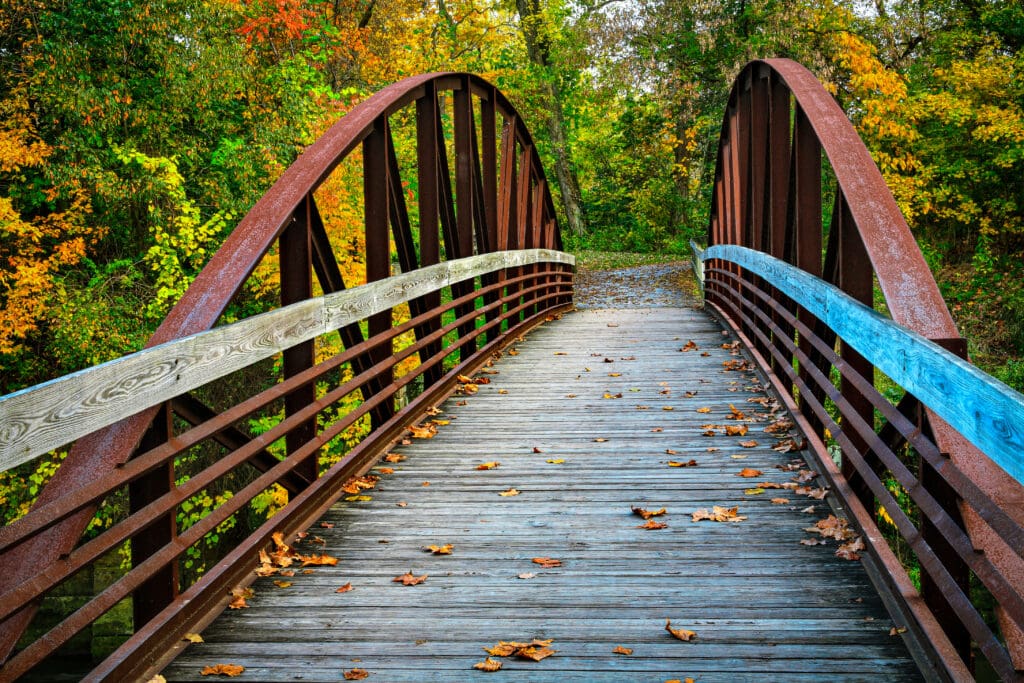
Foot Bridge On The Ohio and ErieTowpath Trail, Cuyahoga Valley National Park, Ohio. Photo: Doug Lemke/Adobe Stock.
Ride the Cuyahoga Valley Scenic Railroad
The Cuyahoga Valley Scenic Railroad Ride offers a unique way to experience the natural beauty of the Cuyahoga Valley National Park. This scenic excursion allows passengers to sit back and relax as the train weaves through the valley, offering views of the rushing Cuyahoga River and the chance to spot wildlife like eagles, deer, beavers, and herons.
The route spans 26 miles and includes stops at various stations, with the option to hop on and off during the day. Additionally, the train features historic cars, including a steam locomotive, and offers themed rides like the “Steam in the Valley” event, where passengers can ride in period clothes for a special trip through the park. The ride is not only a journey through the park’s scenic landscape but also a step back in time, showcasing the historical significance of railroading in the area.
While the train runs throughout the year, the daily schedule changes depending on the season. Before embarking on a point-to-point hike, bike ride, or run, make sure to check the Cuyahoga Valley Scenic Railroad official website to confirm that the train is operating on your desired day.

A steam locomotive rounds a curve in the distance on the Cuyahoga Valley Scenic Railroad. Photo: By Kenneth Sponsler/Adble Stock.
Canal Exploration Center
Learn about the history of the Ohio and Erie Canal at the Canal Exploration Center. The Canal Exploration Center is a fascinating destination located in the heart of the Cuyahoga Valley National Park. This engaging facility offers visitors a unique opportunity to immerse themselves in the rich history of the Ohio & Erie Canal.
The center features interactive exhibits that bring to life the stories of the canal era, a time when the nation’s identity and economy were taking shape. As you explore, you’ll learn about the people who worked tirelessly to realize the Founding Fathers’ vision, and how the canal system played a vital role in the country’s development. The Canal Exploration Center is housed in an old canal-side tavern, with a reconstructed canal lock outside, and is open five days a week, from Wednesday to Sunday.
Discover how this waterway played a crucial role in shaping the region’s development.

Erie Canal Lock in Akron, Ohio
Hiking
The best hiking trails in Cuyahoga Valley National Park offer a variety of experiences for nature enthusiasts. For a scenic adventure, the Ledges Trail is a must-do hike, where you can enjoy massive walls of moss-covered sandstone, known as the Ledges, and a 2.6-mile loop that offers a diverse and enchanting landscape.
If you’re looking for a more challenging hike, the Brandywine Gorge Trail loop is a popular choice, leading to Brandywine Falls, a scenic 65-foot waterfall. This trail is about 3.8 miles long and has an elevation gain of about 442 feet, making it a moderate hike.
For those who prefer a less crowded experience, the Oak Hill and Tree Farm trails are recommended. These trails offer a serene environment for hikers of all abilities.
No matter which trail you choose, Cuyahoga Valley National Park offers a diverse range of hiking experiences that cater to different interests and skill levels. Remember to check the park’s calendar for any special events or guided tours during your visit.

Staircase at the Ledges Trail at Cuyahoga Valley National Park in Ohio. Photo: Zack Frank/Adobe Stock.
Bridal Veil Falls
Bridal Veil Falls in Cuyahoga Valley National Park is a stunning 20-foot waterfall that’s easily accessible via a 0.3-mile out-and-back hike. To reach this natural wonder, park across the street from the trail entrance and follow the well-maintained path. The hike is considered easy, taking an average of 9 minutes to complete. For a more adventurous day, combine your visit with a hike to Tinkers Creek Gorge for breathtaking views.
Remember to wear appropriate footwear and be mindful of wet conditions, especially after rainfall.
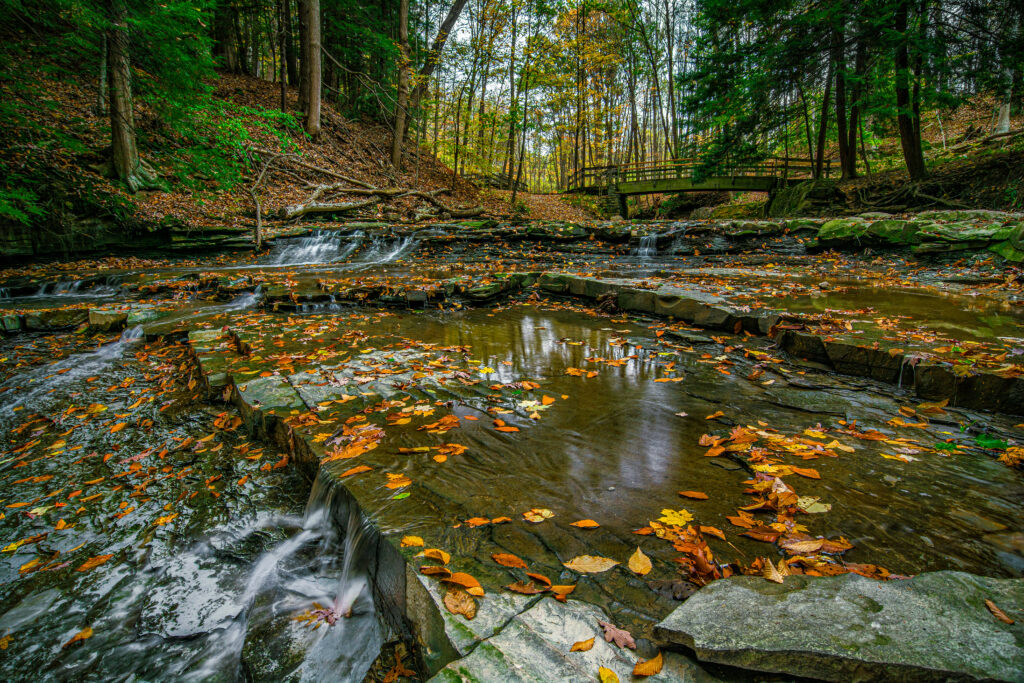
Beautiful autumn scene at Bridal Veil Falls in the Cuyahoga Valley National Park near Cleveland Ohio.
Visit Brandywine Falls
Brandywine Falls in Cuyahoga Valley National Park is a stunning 60-foot waterfall accessible via a partially accessible boardwalk. The falls are located at 8176 Brandywine Road in Sagamore Hills Township, Ohio. Parking for the falls also serves the Summit Metroparks Bike and Hike Trail, making it busy during nice weather and throughout the summer. To fully enjoy the falls, arrive early or during less crowded times. A 1.5-mile Brandywine Gorge Loop allows visitors to explore the area beyond the waterfall, providing views of the creek and geological layers. The Inn at Brandywine Falls offers lodging nearby, overlooking the natural wonder.

Brandywine Falls, located in Cuyahoga Valley National Park, Ohio.
Visit Beaver Marsh
Beaver Marsh was once a dairy farm and then an auto salvage yard, but it has since been transformed back into a thriving wetland. This remarkable restoration was made possible by a combination of human efforts and the return of nature’s engineers, the beavers.
Cuyahoga Valley National Park took control of the property, which was previously a dumping ground for car parts and other waste, in the 1970s. The restoration began in earnest in the 1980s when volunteers, including the Sierra Club, cleaned up small dump sites around what was then called Beaver Marsh. This cleanup effort was crucial in creating a suitable environment for nature to take its course.
Meanwhile, the beavers, after a 150-year absence, moved back into the area. They built dams and lodges, flooding the former wetland and creating deep pools of water. The beavers’ dams also blocked the Ohio & Erie Canal, which runs through the marsh, further enhancing the wetland habitat.
The restoration of Beaver Marsh serves as a testament to nature’s resilience and the power of conservation efforts. It’s a place where wildlife thrives, and it stands as a reminder of what can happen when natural places are protected and natural processes are allowed to occur.
To visit, park at 3801 Riverview Road, Peninsula, OH, 44264 and head north on the Towpath Trail. The trail to the marsh is fully accessible, and the best times to spot wildlife are early morning and late evening. This 70-acre marsh, among the most diverse natural communities in the park, is a testament to nature’s resilience and the power of conservation efforts. It’s a must-see for bird enthusiasts and nature lovers alike.
Good to Know: Read more about the Story of the Beaver Marsh. Attend a ranger-led hike at the Beaver Marsh to learn more about the history and wildlife in this area! Check the NPS calendar for upcoming events.

Beaver Marsh in Cuyahoga Valley National Park, between Cleveland and Akron
Visit the Everett Covered Bridge
The Everett Covered Bridge is a historic wooden covered bridge located in Peninsula, Ohio. It is the only remaining covered bridge in Summit County, showcasing a common historic scene from the 1800s when Ohio led the nation with over 2,000 covered bridges. The original bridge was destroyed in a spring storm in 1975, but it was reconstructed in 1986 through a community effort. The bridge’s design reflects a pattern patented by Robert W. Smith in 1867, and it stands as a testament to the area’s history and resilience.
To visit, head to 2370 Everett Road, Peninsula, Ohio 44264. The bridge is accessible via a short walk from the trailhead, which also provides access to nearby horse and hiking trails. The surrounding area offers scenic views, making it a lovely spot for photography and nature walks. The bridge’s proximity to other Cuyahoga Valley National Park attractions, such as Brandywine Falls and the Ohio & Erie Canal Towpath Trail, makes it a convenient stop on a tour of the region.

Everett Covered Bridge.
Visit a Farmer’s Market
The Cuyahoga Valley National Park is a beautiful backdrop for some fantastic farmers’ markets. The Countryside Farmers’ Market is one of the best, offering farm-fresh ingredients from pasture-raised meats to organic produce, just-baked pastries, and more. It operates year-round, with the summer market taking place at Howe Meadow from May to October, and the winter market at Old Trail School from November to April. The market is open every Saturday from 9:00 to 12:00.
For more information and specific dates, you can visit the official website of the Countryside Farmers’ Market. You might also want to check out Szalay’s Sweet Corn Farm, which is located within the park and operates as a farmers market from June to October.
Visit Tinkers Creek Gorge Scenic Overlook
Tinker’s Creek travels 28.2 miles and is the largest tributary that feeds the Cuyahoga River. The creek drops a dramatic 220 feet over a course of two miles and has carved out a steep, walled gorge. The gorge was declared a National Natural Landmark in 1967. Tinker’s Creek Gorge Scenic Overlook offers a spectacular vista particularly in the fall. The Gorge is a National Natural Landmark, which is a site designated by the Secretary of the Interior for its condition, illustrative character, rarity, diversity, and value to science and education. The overlook is wheelchair accessible and located off Gorge Parkway in Bedford Reservation, between Dunham and Egbert roads in Walton Hills.
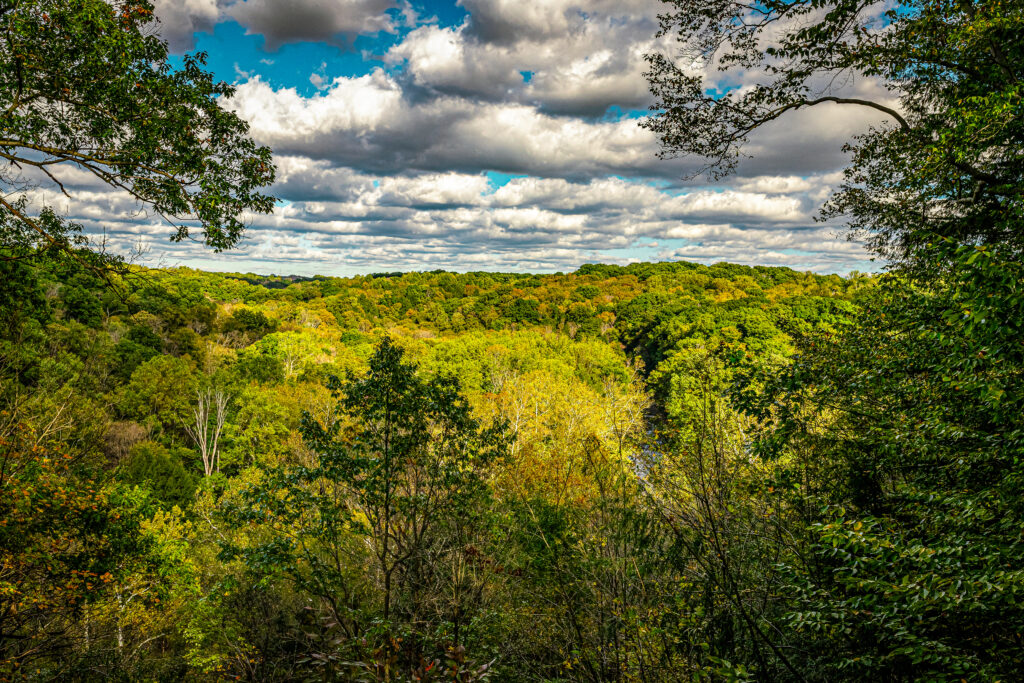
A view of Tinkers Creek from the Gorge Parkway Overlook as it winds its way through Cuyahoga Valley National Park during the Autumn leaf color change in Ohio.
Conclusion
Cuyahoga Valley National Park, established in 2000, is a 33,000-acre oasis nestled between Cleveland and Akron. It boasts diverse landscapes, from deep forests to rolling hills and open farmlands, providing refuge for native plants and wildlife. The winding Cuyahoga River and the historic Ohio & Erie Canal Towpath Trail offer scenic routes for exploration. With over 125 miles of hiking trails, the park is perfect for outdoor enthusiasts. Its unique features include Brandywine Falls and the Ledges Trail. It is the 12th most visited national park in the United States, welcoming nearly 3 million visitors annually.
Enroll With Global Rescue Prior To Embarking On Your Next Adventure.
When a travel emergency arises, traditional travel insurance may not come to your aid, and a medical evacuation can cost up to $300,000.
The cost when you have a Global Rescue membership? $0. That’s why when the unexpected happens, you want the leader in rescue, evacuation and medical advisory behind you. You want Global Rescue.









